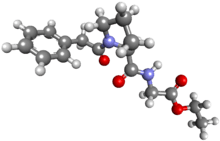Noopept
 | |
 | |
| Legal status | |
|---|---|
| Legal status |
|
| Identifiers | |
| |
| Synonyms | N-Phenylacetyl-L-prolylglycine ethyl ester |
| CAS Number |
157115-85-0 |
| PubChem (CID) | 180496 |
| ChemSpider |
157065 |
| Chemical and physical data | |
| Formula | C17H22N2O4 |
| Molar mass | 318.367 g/mol |
| 3D model (Jmol) | Interactive image |
| |
| |
| | |
Noopept (Russian: Ноопепт; GVS-111, N-phenylacetyl-L-prolylglycine ethyl ester) is a peptide promoted and prescribed in Russia and neighbouring countries as a nootropic. The registered brand name Noopept (Ноопепт) is trademarked by the manufacturer JSC LEKKO Pharmaceuticals. The compound is patented in both the US and Russia with patent of Russian Federation number 2119496, U.S. Patent 5,439,930 issued 8/8/1995.[1] It is sold as a dietary supplement in the US and as a medication in other countries.
Mechanism of action

Noopept is not a racetam (due to not having a 2-oxo-pyrrolidine skeleton),[2] but is generally grouped together in the same category because it shares similar mechanisms of action with the racetam family, mainly modulation of the acetylcholine system, as well as modulation of AMPA receptors.[3] When compared to traditional racetams, it has been found to be, according to studies, 1000 times more potent than the prototypical racetam drug, piracetam.[4] Noopept is a prodrug for the endogenous peptide cycloprolylglycine,[5] which means that Noopept isn't active until metabolized into cycloprolylglycine.
Pharmacokinetics
Peak plasma noopept concentrations of 13-33 μg/L are reached within one hour after a single 20 mg oral dose. The half-life averages about 1 hour in healthy individuals. It is mainly cleared renally as a series of metabolites produced by amide and ester hydrolysis, deacylation and aromatic hydroxylation. Noopept may be quantitated in biofluids by liquid chromatography with one of several different detection techniques.[6][7]
References
- ↑ PatentGenius.com http://www.patentgenius.com/patent/5439930.html
- ↑ "Noopept Information". Examine.com. Retrieved 27 May 2015.
- ↑ Gudasheva TA, Boyko SS, Ostrovskaya RU, Voronina TA, Akparov VK, Trofimov SS, Rozantsev GG, Skoldinov AP, Zherdev VP, Seredenin SB (1997). "The major metabolite of dipeptide piracetam analogue GVS-111 in rat brain and its similarity to endogenous neuropeptide cyclo-L-prolylglycine". European Journal of Drug Metabolism and Pharmacokinetics. 22 (3): 245–52. doi:10.1007/BF03189814. PMID 9358206.
- ↑ Ostrovskaia RU, Gudasheva TA, Voronina TA, Seredenin SB (2002). "[The original novel nootropic and neuroprotective agent noopept]". Eksperimentalnaia i Klinicheskaia Farmakologiia (in Russian). 65 (5): 66–72. PMID 12596521.
- ↑ Ostrovskaya RU, Mirsoev TK, Romanova GA, Gudasheva TA, Kravchenko EV, Trofimov CC, Voronina TA, Seredenin SB (2001). "Proline-containing dipeptide GVS-111 retains nootropic activity after oral administration". Bulletin of Experimental Biology and Medicine. 132 (4): 959–62. PMID 11782792.
GVS-111 principally differs from its main metabolite cycloprolylglycine
- ↑ S.S. Boiko, S.A. Korotkov, V.P. Zherdev et al. Interspecific differences of noopept pharmacokinetics. Eksp. Klin. Farmakol. 67: 40–43, 2004.
- ↑ R. Baselt, Disposition of Toxic Drugs and Chemicals in Man, 10th edition, Biomedical Publications, Seal Beach, CA, 2014, p. 1524-1525. http://www.biomedicalpublications.com/noopept.pdf